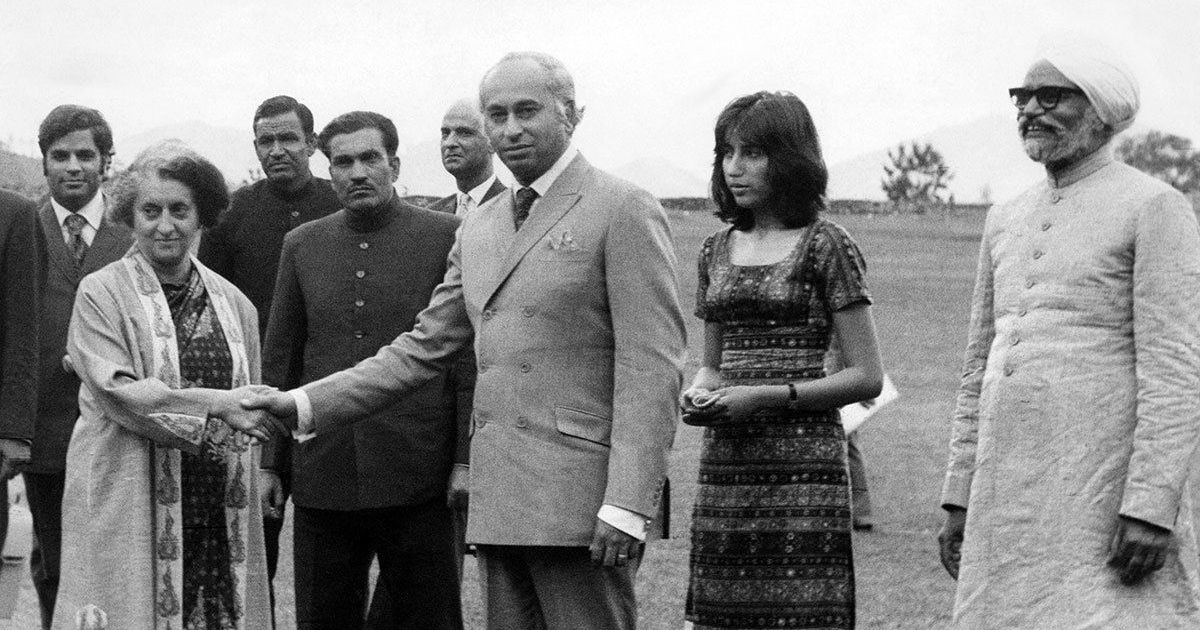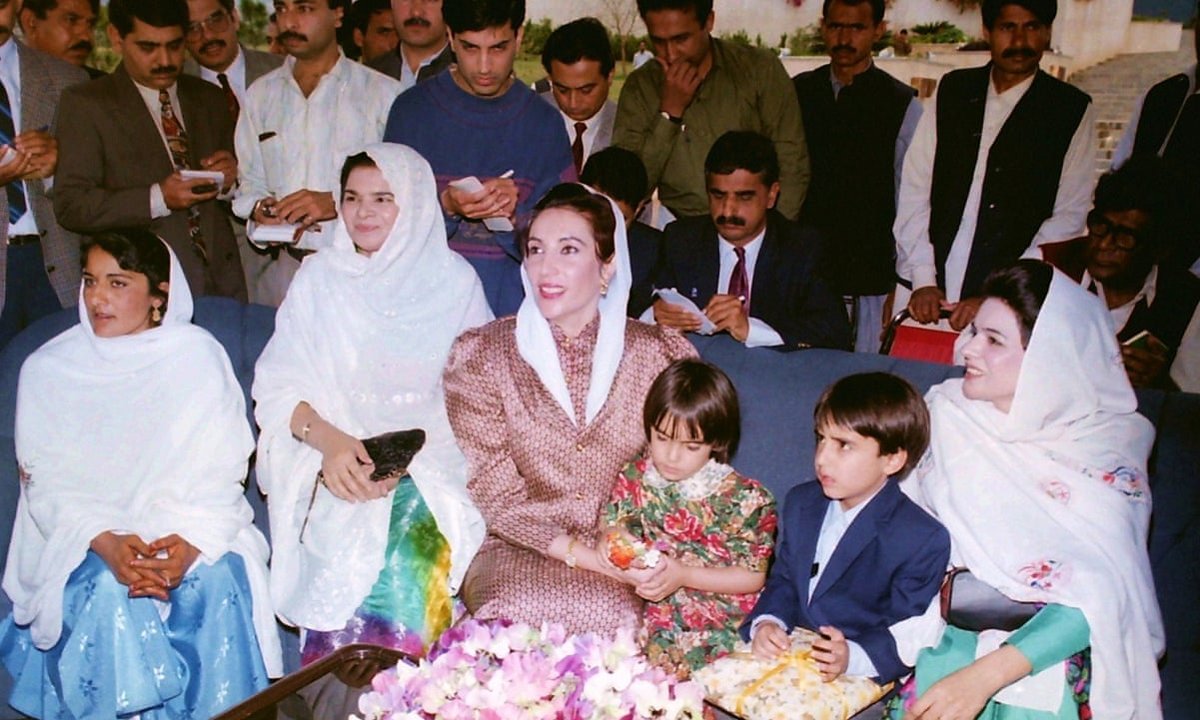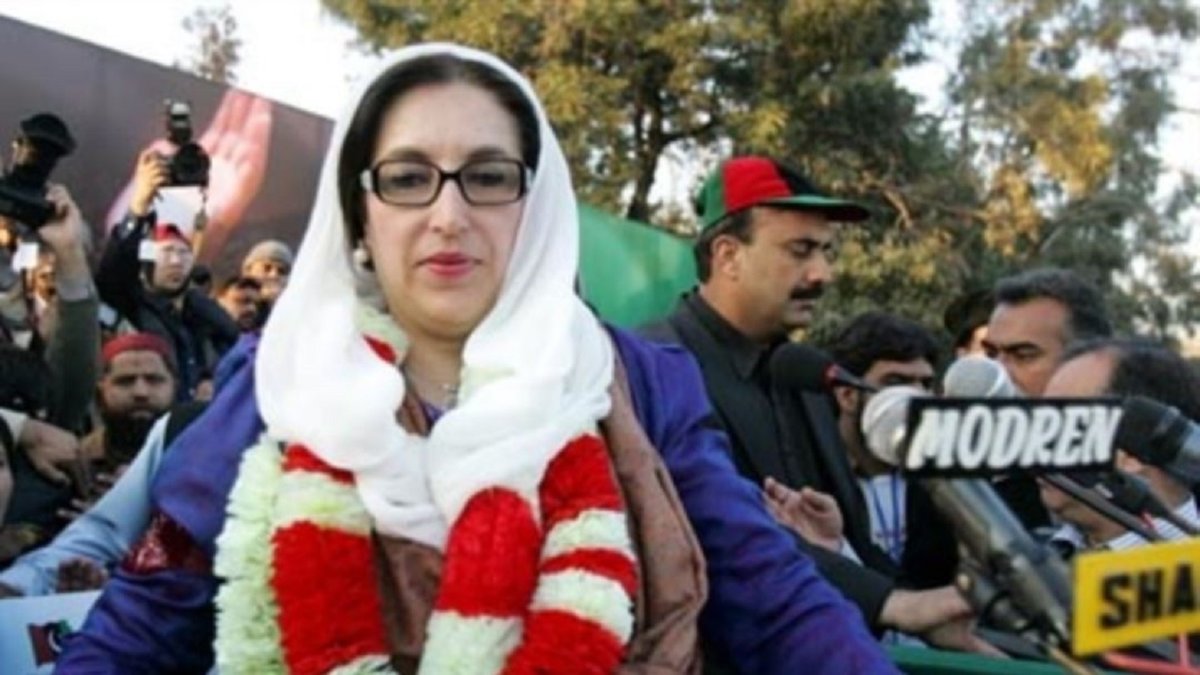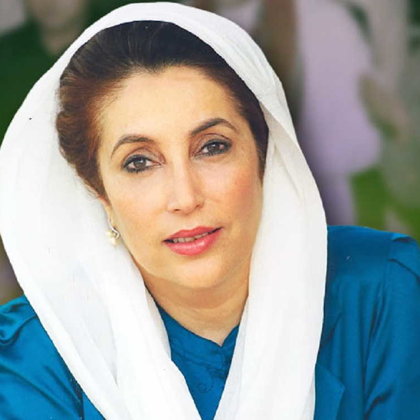BENAZIR BHUTTO (1953 - 2007) WAS A PAKISTANI POLITICIAN.SHE WAS THE ELDER DAUGHTER OF PRIME MINISTER ZULFIQAR ALI BHUTTO.AFTER HER FATHER WAS HANGED TO DEATH,HER FAMILY WAS REPEATEDLY PUT UNDER HOUSE ARREST BY REGIME OF ZIA UL HAQ.IN 1988,BHUTTO WAS THE FIRST OMAN EVER ELECTED TO GOVERN IN PAKISTAN.BENAZIR BHUTTO WAS ASSASSINATED IN RAWALPINDI,THE CITY IN WHICH HER FATHER WAS HANGED IN 1979.
 Pakistani President Zulfikar Alî Bhutto (centre) shakes hands with India's Prime Minister Indira Gandhi in Shimla on June 28, 1972, while his daughter Benazir Bhutto (second from right) and Indian Foreign Minister Swaran Singh (right) look on.Emulating Nehru: How Zulfikar Ali Bhutto’s letter to daughter Benazir from jail became his legacy.Pakistan’s deposed prime minister wanted to be kept alive by history, even if Zia-ul-Haq’s military regime killed him.
Pakistani President Zulfikar Alî Bhutto (centre) shakes hands with India's Prime Minister Indira Gandhi in Shimla on June 28, 1972, while his daughter Benazir Bhutto (second from right) and Indian Foreign Minister Swaran Singh (right) look on.Emulating Nehru: How Zulfikar Ali Bhutto’s letter to daughter Benazir from jail became his legacy.Pakistan’s deposed prime minister wanted to be kept alive by history, even if Zia-ul-Haq’s military regime killed him.
Benazir Bhutto was born June 21, 1953, in Karachi, Pakistan. Her name means “one without equal.”She attended Catholic schools in Pakistan. She entered Harvard University’s Radcliffe College at age 16 and earned a cum laude degree in comparative government in 1973. She went on to Oxford University where she was the first Asian woman to be elected president of the Oxford Union.Her father, Zulfikar Ali Bhutto, was the founder of the Pakistan People’s Party. In 1986, when Bhutto returned to Pakistan from exile in Britain, she was greeted by such large crowds that it took her motorcade 9 ½ hours to travel the 8 miles from the airport to a rally site in Lahore.Bhutto once mentioned that former Prime Minister Margaret Thatcher, Britain’s “Iron Lady,” was her role model but noted: “As a Muslim woman, I have great respect for Khadija, wife of the prophet of Islam, because she was a working woman.After her father was hanged to death, her family was repeatedly put under house arrest. The then regime finally imprisoned her under solitary confinement in a desert cell in Sindh in summer 1981.Bhutto was the first woman elected to lead a Muslim state. She was elected Prime Minister of Pakistan two times. She was sworn in for the first time in 1988 but removed from office 20 months later under orders of then-president Ghulam Ishaq Khan on a belief that she was corrupt. In 1993 Bhutto was re-elected but was again removed in 1996 on similar charges, this time by President Farooq Leghari.Popularly known as the Iron Lady of Pakistan, Benazir Bhutto opened the doors of politics for women in Pakistan. Not only did she become the first woman to head a major political party, but she went on to become the first and till date, the only female Prime Minister of Pakistan. She served this powerful position twice in her lifetime. Born in a prominent political family, she was exposed to political thoughts and beliefs since a young age. The imprisonment and the subsequent execution of her father, Zulfikar Ali Bhutto, brought Benazir into the centre stage of Pakistan politics as she succeeded her father as the titular head of the Pakistan People’s Party. Most of her ideals were centred on democratic and social capitalist policies. Her charismatic presence coupled with political shrewdness and unabated courage earned her the nickname ‘Iron Lady’. Most of her contemporaries and rivals respectfully addressed her as ‘B.B’. During her term as the Prime Minister from 1988 until 1990 and 1993 until 1996, she brought about several political and economic policies for industrial development and growth. She favoured denationalisation of state-owned corporations and took a hard stand against trade unions and rigid labour markets. However, high levels of corruption, escalating unemployment and stifling recession brought about an end to her governance. To know more about her life and profile, scroll further. Upon her return to Pakistan in 1977, she along with her family was placed under house arrest following the dethronement of her father Zulfikar Ali Bhutto from the prime ministership and the emergence of General Mohammad Zia ul-Haq to power.She inherited the leadership of her father’s political party, Pakistan People’s Party (PPP) and spent the next two years organizing rally to force General Haq to drop murder charges against her father.Against local plea and international pressure, Zulfikar Ali Bhutto was hanged on April 1979, following which she was arrested and moved to Larkana Central Jail. In 1981, she was imprisoned in a desert cell in Sindh Province.
On 6 August 1990,THE FALL OF BENAZIR BHUTTO'S GOVERNMENT. Prime Minister Benazir Bhutto was dismissed by President Khan, who also announced the dissolution of the Federal Assembly and the provincial assemblies voted in at the November 1988 elections. At the same time, he declared a state of emergency throughout the country, citing "the threat of outside aggression and internal unrest as beyond the provincial governments' control." President Khan justified these measures by accusing the Bhutto government of corruption, abuse of power and the inability to end violence in Sindh province (The New York Times 7 Aug. 1990, A1; Le Monde 8 Aug. 1990). He also maintained that Bhutto had attempted to corrupt parliamentarians, ridicule the judicial system and impede the smooth operation of provincial governments . These explanations hardly disguise the real reason for the dismissal of Benazir Bhutto. Most observers consider that by intervening constantly in army affairs, she underestimated the influence of an institution which tolerates democracy on condition that the civilian government does not interfere with its "vital interests" (Far Eastern Economic Review 4 Oct. 1990a, b; Le Monde 8 Aug. 1990, 11 Sept. 1990).Benazir Bhutto's dismissal raised a storm of protests. On 14 August, thousands of demonstrators gathered at the mausoleum of Ali Jinnah in Karachi. Hundreds of police then charged supporters of Benazir Bhutto's PPP, leaving twenty injured, including three press photographers (Libération 15 Aug. 1990).To replace Benazir Bhutto, President Khan appointed Ghulam Mustafa Jatoï, an opposition leader, to head an interim government composed mainly of members of the Islamic Democratic Alliance (IDA) coalition. In addition, he announced legislative elections for 24 October and elections for the four provincial parliaments three days later . President Khan intimated that the 24 October election should sanction the change of government ordered in August. The election campaign was marred by many irregularities.Succumbing to immense international pressure, she along with her family was allowed to travel abroad in 1984 for medical aid. Following her recuperation, she resumed her political pursuit, becoming a leader in exile for PPP, raising awareness of the state of political prisoners and human right violation under Zia regime.In 1986, she returned to Pakistan after two years of self-exile upon the lifting of the martial law and launched a nationwide campaign for open elections.In 1988, a mysterious air accident caused the death of General Haq, leaving a vacuum in Pakistan politics and the need for elections.In the 1988 elections, the PPP party led by her emerged as the winner, winning the largest percentile of seats in the National Assembly. She was designated to the prime ministerial position on December 2, 1988, thus becoming the first woman prime minister of a Muslim state.During her first term as prime minister, she could not do much to combat the problems of poverty, corruption and crime. Moreover, her aim to shift Pakistan's semi-presidential system to a parliamentary system also turned out to be a failure as most of the proposed laws were vetoed by conservative President Ghulam Ishaq Khan.In 1990, following the failure to curb corruption and unemployment and the downfall in the economic graph of the country, President Khan ousted her from the Prime Minister position using the Eight Amendment with charges of corruption, nepotism and despotism.In the 1990 elections that occurred at the aftermath of her expulsion, her party failed to register a victory and opposition leader Nawaz Shariff succeeded the chair. She accepted her defeat and took over the role of the Leader of Opposition.Following the resignation of Nawaz Sharif and President Khan in 1993, elections were held and PPP party won the same. She was elected for a second term as the Prime Minister of Pakistan. She appointed Farooq Leghari as the President.During election campaign Benazir promised promised price supports for agriculture, pledged a partnership between government and business and campaigned strongly for the female vote. However, once in power, she was not able to implement any of her agendas and failed miserably.She was neither able to contain racial tension that was at its peak in Karachi nor corruption scandals which only worsened the economic condition of the country. Furthermore, women issues were not dealt with as no reforms were made and controversial laws were instead exercised more toughly.She had promised denationalization programme and liberalisation of the economy during her second term but none of the same ever occurred. As such, inflation and unemployment increased thus causing a decline in the living standard of the people.With the ever increasing corruption and death of younger brother, the credibility of her government declined. It faced harsh criticism became hugely unpopular amongst the public, a result of which was dismissal of her government in 1996.In 1997, she moved to Dubai along with her children to escape the corruption charges by the Nawaz Sharif government. Her husband, Asif Ali Zardari was held in captive and imprisoned.From 1996 until 1999, she became the Leader of the Opposition in exile in the Parliament. In 1999, Pakistan’s involvement in Kargil War brought about international shame for the country and hindered Shari’s public image. Benazir capitalized on the situation and gathered support for herself.She aimed to bring her PPP party back in action but when Pakistan Armed forces adopted the coup d' tat, she supported the same. With General Pervez Musharraf’s ascend to power, her demand for corruption charges being dropped were denied. As a result, she remained in exile in London and Dubai.In 2002, when Pervez Musharraf amended the Pakistan constitution, banning prime ministers from serving more than two terms, her chance to hold office ever again was disrupted. Furthermore, prohibition for a court-convicted individual from holding party office made it impossible for her to compete in the elections.In 2007, she returned after serving eight years of self-imposed exile. All charges against her were pardoned by Musharraf and a power-sharing deal between Bhutto and Musharraf’s military regime came into force.
 Benazir Bhutto showed you can be a mother and prime minister.At the time, as her children, we didn’t appreciate how extraordinary her life was. Looking back it is clear that despite her accomplishments, every day she had to prove that as a woman she had every right to be who she was, larger than life and leading from the front, every step of the way.
Benazir Bhutto showed you can be a mother and prime minister.At the time, as her children, we didn’t appreciate how extraordinary her life was. Looking back it is clear that despite her accomplishments, every day she had to prove that as a woman she had every right to be who she was, larger than life and leading from the front, every step of the way.
On December 27, 2007, Benazir Bhutto was killed while getting into a vehicle to leave a political meeting for the Pakistan Peoples Party in Rawalpindi, Pakistan. An assassin shot her in the neck and chest before detonating an explosive vest. This killed about 30 people and wounded many others.Pakistani politician Benazir Bhutto was killed at a campaign rally.After the martyrdom of Benazir Bhutto the dynamics of Bilawal Bhutto Zardari and Asif Ali Zardari’s relationship changed drastically. They started conversing on serious matters, very candidly. It has also been reported that Bilawal Bhutto Zardari is seriously concerned about his father’s physical and mental health and fears not to question him. . Almost seven years later, it's still unclear who was behind the assassination even though arrests have been made, official reports have been filed, and certain outsider groups have claimed responsibility.Even the cause of Bhutto's death is disputed: Was she felled by bullets? Or did a 15-year-old suicide bomber end her life along with his own and those of 20 others that December day? Did that boy act alone, or did he have a single accomplice, or was he backed by a powerful anti-Bhutto organization?Bhutto, who twice led Pakistan as prime minister and was seeking a third term at the time of her death, would have celebrated her 61st birthday June 21. Here are five facts about Bhutto, her assassination and the conclusions some have drawn. Bhutto’s father, Zulfikar Ali Bhutto, founder of the Pakistan Peoples Party, was president and then prime minister of Pakistan from 1971 until a military coup ousted him in 1977. He was hanged in April 1979. Bhutto was 29 when she took the helm of the Peoples Party.In 1988, Bhutto was the first woman ever elected to lead a Muslim state. She served twice, from 1988 to 1990, and from 1993 to 1996. She was expelled from office both times by the president of Pakistan for alleged corruption. Bhutto left Pakistan voluntarily in 1999. She returned in October 2007 and, during her homecoming parade, a suicide bomber detonated in the crowd. More than 140 people were killed. Bhutto survived, noting at the time, "We will not be deterred," according to media reports. During a rally a few months later, she shouted, "Bhutto is alive!" The Musharraf government claimed Taliban leader Baitullah Mehsud masterminded Bhutto's assassination. The U.S. government agreed, the CIA's chief at the time, Michael Hayden, told media outlets in 2008 including The Washington Post. Mehsud was killed by a Predator drone attack in September 2009. In 2010, the United Nations concluded Bhutto was probably killed by al-Qaida and its Pakistani Taliban allies who recruited the 15-year-old suicide bomber. It also said that the government of military leader Musharraf ignored Bhutto's requests for better security and then tried to cover up the alleged crime. In 2013, Musharraf was arrested on treason charges including alleged involvement in Bhutto's murder. As of May 2014, the cases were still pending. In the 2013 book "Getting Away with Murder: Benazir Bhutto's Assassination and the Politics of Pakistan," Chilean diplomat Heraldo Munoz, who oversaw the U.N.'s investigation, noted that some believe Bhutto's family and her security detail were behind her killing. Others say Musharraf ordered her death."We will probably never know with full certainty who killed Bhutto. The list of people and groups that considered Bhutto a hated enemy is long. There are pieces of the murder puzzle but painfully few elements to put them all together," Munoz wrote. "It may well be that Bhutto’s assassination will be another unsolved case in the long history of impunity in Pakistan, and that the controversy surrounding her assassination will endure as much as her memory.
 Top officials working during the Musharraf regime at the time of Benazir Bhutto’s assassination may be arrested in the light of a new inquiry report, whose findings were not shared with top PPP leaders.The inquiry, third such investigation into the assassination, was completed under the direct supervision of Interior Minister Rehman Malik, who has been working on it for the past three years after quietly securing permission of President Asif Ali Zardari after becoming the interior minister in April 2008
Top officials working during the Musharraf regime at the time of Benazir Bhutto’s assassination may be arrested in the light of a new inquiry report, whose findings were not shared with top PPP leaders.The inquiry, third such investigation into the assassination, was completed under the direct supervision of Interior Minister Rehman Malik, who has been working on it for the past three years after quietly securing permission of President Asif Ali Zardari after becoming the interior minister in April 2008

 Benazir Bhutto showed you can be a mother and prime minister.At the time, as her children, we didn’t appreciate how extraordinary her life was. Looking back it is clear that despite her accomplishments, every day she had to prove that as a woman she had every right to be who she was, larger than life and leading from the front, every step of the way.
Benazir Bhutto showed you can be a mother and prime minister.At the time, as her children, we didn’t appreciate how extraordinary her life was. Looking back it is clear that despite her accomplishments, every day she had to prove that as a woman she had every right to be who she was, larger than life and leading from the front, every step of the way.